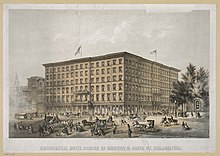
The Philadelphia Museum of Art (PMoA) is an art museum originally chartered in 1876 for the Centennial Exposition in Philadelphia. The main museum building was completed in 1928 on Fairmount, a hill located at the northwest end of the Benjamin Franklin Parkway at Eakins Oval. The museum administers collections containing over 240,000 objects including major holdings of European, American and Asian origin. The various classes of artwork include sculpture, paintings, prints, drawings, photographs, armor, and decorative arts.

The Bellevue-Stratford Hotel is a landmark building at 200 S. Broad Street at the corner of Walnut Street in Center City Philadelphia, Pennsylvania. Constructed in 1904 and expanded to its present size in 1912, it has continued as a well-known institution for more than a century and is still widely known by that original, historic name. In 1988, the building was converted to a mixed-use development. It has been known since then as The Bellevue. The hotel portion is currently managed by Hyatt as The Bellevue Hotel.
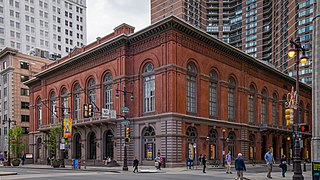
The Academy of Music, also known as American Academy of Music, is a concert hall and opera house located at 240 S. Broad Street in Philadelphia, Pennsylvania. Despite its name, the Academy has never contained a music school. It is located between Locust and Manning Streets in the Avenue of the Arts area of Center City.

The William Pitt Union, which was built in 1898 as the Hotel Schenley, is the student union building of the University of Pittsburgh main campus, and is a Pennsylvania and Pittsburgh History and Landmarks Foundation Historic Landmark.

The Powel House is a historic house museum located at 244 South 3rd Street, between Willings Alley and Spruce Street, in the Society Hill neighborhood of Philadelphia, Pennsylvania. Built in 1765 in the Georgian style, and embellished by second owner Samuel Powel (1738–1793), it has been called "the finest Georgian row house in the city." As with other houses of this type, the exterior facade is understated and simple, but the interior was elaborately appointed.
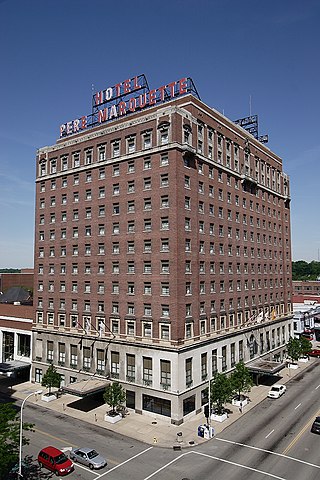
The Peoria Marriott Pere Marquette, is a historic 14-story hotel in downtown Peoria, Illinois, United States. Built in 1926, the building is Peoria's only surviving example of an upscale 1920s hotel. It was listed on the National Register of Historic Places in 1982.

Horace Trumbauer was a prominent American architect of the Gilded Age, known for designing residential manors for the wealthy. Later in his career he also designed hotels, office buildings, and much of the campus of Duke University.

Franklin Square is one of the five original open-space parks planned by William Penn when he laid out the city of Philadelphia, Pennsylvania, in 1682. It is located in the Center City area, between North 6th and 7th streets, and between Race Street and the Vine Street Expressway (I-676).

The Grey Towers Castle is a building on the campus of Arcadia University in Glenside, Pennsylvania, which is located in Cheltenham Township, a suburb of Philadelphia, United States. The castle was designed by Horace Trumbauer and built starting in 1893 on the estate of William Welsh Harrison.

G. W. & W. D. Hewitt was a prominent architectural firm in the eastern United States at the turn of the twentieth century. It was founded in Philadelphia in 1878, by brothers George Wattson Hewitt (1841–1916) and William Dempster Hewitt (1847–1924), both members of the American Institute of Architects. The firm specialized in churches, hotels and palatial residences, especially crenelated mansions, such as Maybrook (1881), Druim Moir (1885–86) and Boldt Castle (1900–04).
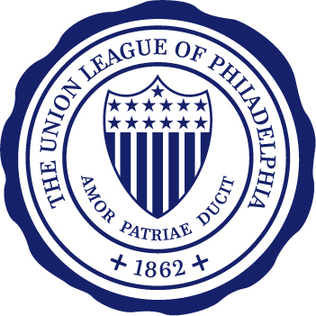
The Union League of Philadelphia is a private club founded in 1862 by the Old Philadelphians as a patriotic society to support the policies of Abraham Lincoln. As of 2022, the club has over 4,000 members. Its main building was built in 1865 and added to the National Register of Historic Places in 1979.
Helen Hope Montgomery Scott was a socialite and philanthropist who Vanity Fair labeled "the unofficial queen of Philadelphia's WASP oligarchy." She was the inspiration for Tracy Lord, the main character in the Philip Barry play The Philadelphia Story, which was made into the film of the same name and the musical film High Society.

The Battle House Renaissance Mobile Hotel & Spa, is a historic hotel in Mobile, Alabama. The current structure was built in 1908 as the Battle House Hotel. It is the second hotel by that name to stand in this location, replacing an earlier Battle House built in 1852, which burned down in 1905. It is one of the earliest steel frame structures in Alabama.

The Dearborn Inn, A Marriott Hotel is a historic hotel in the suburban city of Dearborn, Michigan in Metro Detroit. It opened in 1931 and closed in February 2023 for renovations. It was conceived by Henry Ford, who saw a need for food and accommodations for visitors flying into the nearby Ford Airport, making it one of the first airport hotels. It is located at 20301 Oakwood Boulevard near The Henry Ford and the world headquarters building of Ford Motor Company. Albert Kahn designed the Dearborn Inn in the Georgian architectural style. The Dearborn Inn is owned by Ford Motor Land Development Corporation and managed by Marriott International.

Philadelphia Club was founded in 1834 and is located at 13th and Walnut Streets in Center City Philadelphia. It is the oldest city club in the United States and one of the oldest gentlemen's clubs. Notable members have included George Meade, Owen Wister, and many members of the Du Pont and Biddle families.

John Torrey Windrim was an American architect. His long time chief designer was W. R. Morton Keast.
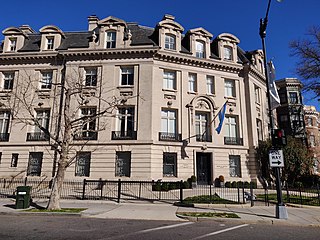
The Embassy of Argentina in Washington, D.C. is the Argentine Republic's diplomatic mission to the United States. It is located at 1600 New Hampshire Avenue, Northwest, Washington, D.C. The current Ambassador of Argentina to the USA is Jorge Argüello.

Warburton House, also known as the Warburton Hotel and The Lucy Eaton Smith Residence, is an historic, American hotel that is located in the Rittenhouse Square East neighborhood of Philadelphia, Pennsylvania. It was named for Lucy Eaton Smith, whose name in religious life was Mother Mary Catherine De Ricci of the Sacred Heart, who founded a Dominican pontifical institute in Albany, New York.

Franklin Court is a complex of museums, structures, and historic sites within Independence National Historical Park in Philadelphia, Pennsylvania. It is located at the site which American printer, scientist, diplomat, and statesman Benjamin Franklin had his Philadelphia residence from 1763 to his death in 1790.
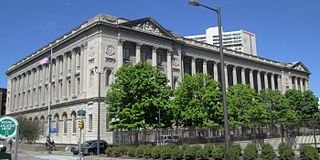
The Philadelphia Family Court Building, also known as Juvenile and Domestic Branches of the Municipal Court, is a historic building in Center City Philadelphia and registered under National Park Service's, National Register of Historic Places.




